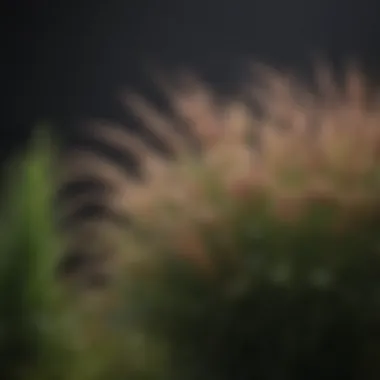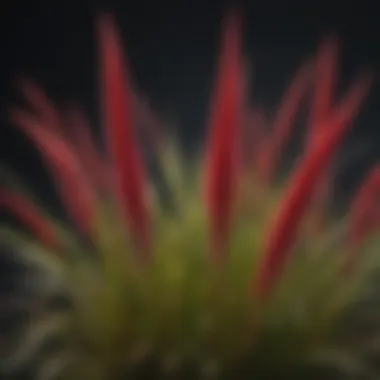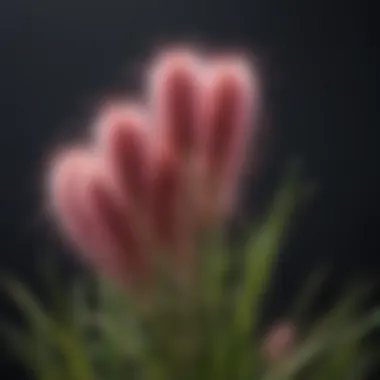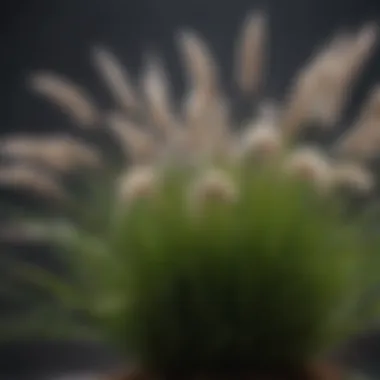Unveiling the Diverse World of Fountain Grass: A Complete Exploration


Plant Species Profile
Fountain grass is a diverse plant species known for its ornamental appeal in landscaping. With distinct characteristics, growth habits, and ideal growing conditions, fountain grass offers a variety of options for enhancing outdoor spaces.
Fountain Grass Varieties
Fountain grass encompasses various types, each with its unique features. From the Pennisetum setaceum 'Rubrum', known for its deep red foliage, to the Pennisetum alopecuroides 'Hameln', a compact variety ideal for borders, these plants present a range of options for different landscaping needs.
Characteristics and Growth Habits
The fountain grass family displays traits like feathery plumes, graceful arching foliage, and vibrant colors, adding texture and movement to garden settings. These grasses exhibit different growth habits, from clumping forms to mound-shaping varieties, providing versatility in design and aesthetic appeal.
Ideal Growing Conditions
To thrive, fountain grass requires adequate sunlight, well-drained soil, and moderate watering. Selecting the right location based on the specific variety's sunlight and soil preferences is crucial for ensuring healthy growth and vibrant foliage. Understanding the unique needs of each type is key to successful cultivation and longevity.
Conservation & Sustainability Efforts
Given the growing interest in eco-friendly landscaping practices, it is essential to consider the conservation and sustainability aspects of incorporating fountain grass into outdoor environments.
Environmental Impact
Understanding the impact of fountain grass cultivation on local ecosystems is crucial for promoting sustainable landscaping practices. Being mindful of water conservation, pesticide usage, and habitat preservation can contribute to reducing the environmental footprint associated with maintaining ornamental grasses.
Conservation Initiatives
Exploring initiatives aimed at preserving native grass species and promoting biodiversity can provide valuable insights for incorporating fountain grass responsibly. Engaging with conservation organizations and participating in community-driven projects can support ongoing efforts to protect natural habitats and promote sustainable landscaping practices.
Success Stories
Celebrating successful sustainability projects that highlight the positive outcomes of conscious landscaping choices can inspire individuals to make informed decisions about their outdoor spaces. Sharing stories of restoration, habitat enhancement, and community involvement can showcase the transformative power of conservation efforts.
Synthesis and Conclusion
Introduction
In this detailed exploration of fountain grass diversity, we embark on a journey to unravel the nuances of various fountain grass species. The significance of understanding these distinct ornamental grasses lies in the enrichment they bring to landscaping designs. By delving deep into the unique characteristics, growth habits, and ideal conditions of each fountain grass type, readers will glean invaluable insights into how to effectively integrate these plants into their outdoor spaces. From the ornate Pennisetum setaceum to the elegant Pennisetum villosum, each variety offers a myriad of possibilities for enhancing the aesthetic appeal of gardens and landscapes. Through this comprehensive guide, we aim to provide a holistic understanding of fountain grass varieties, empowering enthusiasts to make informed decisions when selecting and caring for these ornamental plants.


Understanding Fountain Grass
Understanding Fountain Grass is crucial in this article as it offers in-depth insights into the diverse world of fountain grass varieties. By delving into the specifics of each type, readers can grasp the unique characteristics, growth habits, and ideal growing conditions essential for optimizing their landscaping designs. The meticulous examination of Understanding Fountain Grass provides a foundation for selecting the most suitable variety for a specific environment, ensuring successful cultivation and aesthetic enhancement.
Pennisetum setaceum
Growth Habits
The growth habits of Pennisetum setaceum exhibit a rapid and vigorous nature, thriving in warm climates with ample sunlight. This attribute makes it an ideal choice for regions with extended growing seasons, as it can quickly establish and fill out garden spaces. However, its efficacy in spreading might lead to overcrowding if not monitored closely, necessitating strategic pruning and containment measures for optimal growth control.
Ideal Conditions
Pennisetum setaceum thrives in well-drained soil and excels in areas with full sun exposure. Its preference for warm temperatures makes it suitable for tropical and subtropical regions, where it can reach its full ornamental potential. While its adaptability enables it to tolerate various soil types, ensuring consistent moisture levels is crucial for sustaining its lush appearance throughout the growing season.
Pennisetum alopecuroides
Characteristics
Pennisetum alopecuroides distinguishes itself with its mounded growth habit and tufted appearance, creating a charming display in garden landscapes. The ornamental grass's hardy nature makes it a popular choice for adding texture and visual interest to outdoor spaces, enhancing the overall aesthetics with its unique form.
Cultural Requirements
The cultural requirements of Pennisetum alopecuroides emphasize its adaptability to diverse soil conditions and its resilience to fluctuating temperatures. This versatility allows it to thrive in varied environments, providing a versatile option for landscaping projects seeking a resilient and low-maintenance ornamental grass.
Landscaping Uses
Pennisetum alopecuroides is favored for its versatility in landscaping applications, offering options for borders, mass plantings, and accent features in garden designs. Its ability to complement a wide range of plants and hardscape elements makes it a sought-after choice for creating cohesive and visually appealing outdoor landscapes.
Pennisetum orientale
Distinct Features
Pennisetum orientale stands out with its graceful arching stems and delicate plumes, adding a soft and romantic touch to garden settings. The ornamental grass's feathery inflorescences sway gently in the breeze, creating a mesmerizing visual effect that enhances the overall ambiance of outdoor spaces.
Maintenance Tips
Maintaining Pennisetum orientale involves regular pruning to remove spent plumes and promote new growth, ensuring its continued vigor and beauty. Proper care and attention to grooming practices enable this grass to flourish while preventing it from becoming unsightly or crowded, preserving its aesthetic value throughout the growing season.
Suitable Environments


Pennisetum orientale thrives in locations with well-drained soil and partial shade, appreciating shelter from intense sunlight during the hottest parts of the day. Its preference for moderate conditions makes it well-suited to temperate climates, where it can bloom profusely without experiencing stress from extreme temperatures.
Pennisetum purpureum
Unique Traits
Pennisetum purpureum boasts unique purple-hued foliage that sets it apart from other fountain grass varieties, adding a pop of color to garden landscapes. This distinctive feature makes it a standout choice for creating eye-catching focal points and visual contrasts within outdoor settings.
Optimal Care
Providing optimal care for Pennisetum purpureum involves regular watering and fertilization to maintain its vibrant foliage color and vigorous growth. This grass thrives in nutrient-rich soil and benefits from occasional grooming to remove dead or damaged foliage, ensuring it remains healthy and attractive throughout the growing season.
Applications in Gardens
Pennisetum purpureum enhances garden aesthetics with its bold coloration and dramatic appeal, serving as a versatile element in various landscaping designs. Whether used as a standalone feature or integrated with other plants, this fountain grass offers endless possibilities for creating stunning visual compositions that captivate and inspire all who encounter them.
Pennisetum glaucum
Appearance Description
Pennisetum glaucum displays a unique appearance with its compact growth habit and attractive seed heads that resemble small pearls. This distinctive feature adds sophistication to landscape designs, making it a coveted choice for adding texture and visual interest to garden settings.
Growing Requirements
The growing requirements of Pennisetum glaucum include well-drained soil and adequate sunlight to support healthy growth and development. While it can tolerate varying soil conditions, providing optimal drainage is essential to prevent waterlogging and ensure the long-term viability of this ornamental grass in outdoor landscapes.
Landscape Design Ideas
Pennisetum glaucum offers versatile options for landscape design, including border plantings, container arrangements, and focal points within garden beds. Its adaptability to different settings and planting schemes makes it a versatile choice for enhancing outdoor spaces with its unique aesthetic appeal and textural qualities.
Pennisetum villosum
Features
Pennisetum villosum captivates with its fluffy white plumes and mounded growth habit, adding a soft and airy texture to garden landscapes. This ornamental grass's ethereal quality brings a sense of movement and delicacy to outdoor settings, creating a visually dynamic and engaging environment for both human enjoyment and wildlife habitation.
Cultivation Practices


The cultivation practices for Pennisetum villosum involve providing well-drained soil and regular watering to support robust growth and flowering. This grass thrives in sunny locations with good air circulation, promoting optimal health and vigor while deterring the risk of pest infestations or disease development.
Aesthetic Uses
Pennisetum villosum offers a range of aesthetic uses in landscaping, from softening hardscape features to creating border accents and focal points in garden designs. Its ability to blend seamlessly with various plant species and architectural elements makes it a valuable asset in crafting harmonious and visually compelling outdoor environments that evoke a sense of serenity and beauty.
Comparative Analysis of Fountain Grass Varieties
Fountain grass, a versatile and captivating plant, offers a plethora of varieties, each with its unique characteristics and benefits. In this section, we delve into the comparative analysis of fountain grass varieties, shedding light on the crucial factors to consider when choosing the most suitable option for your landscaping needs.
Importance of Comparative Analysis
Understanding the distinctions between various fountain grass varieties is essential for designing a coherent and aesthetic landscape. By conducting a comparative analysis, you gain insights into the growth patterns, maintenance requirements, and visual appeal of each type, facilitating informed decision-making in landscape design.
Benefits of Comparative Analysis
Comparative analysis aids in identifying the optimal fountain grass variety based on factors like climate adaptability, sun exposure preferences, and water requirements. This evaluation ensures that you select a variety that thrives in your specific environment, promoting the longevity and vibrancy of your landscape.
Considerations for Comparative Analysis
When comparing fountain grass varieties, consider aspects such as height variations, foliage colors, flowering patterns, and tolerance to environmental stressors. These considerations enable you to create dynamic visual contrasts, seasonal interest, and resilience in your landscaping composition.
With a detailed comparative analysis of fountain grass varieties, you can curate a visually engaging and sustainable landscape that harmonizes with its surroundings while elevating the aesthetic appeal of your outdoor spaces.
Best Practices for Fountain Grass Care
Fountain grass care is a crucial aspect of maintaining the health and vibrancy of these ornamental plants. Implementing the best practices ensures that fountain grass thrives in its environment, enhancing the overall aesthetic appeal of your landscaping. To start, regular watering is essential to keep fountain grass hydrated and flourishing. Adequate moisture levels promote healthy growth and prevent wilting or browning of the foliage. Additionally, proper pruning is key to removing dead or overgrown stems, promoting new growth and maintaining a neat appearance. When pruning, ensure to use sharp and clean tools to prevent any damage to the plant.
Furthermore, fertilizing fountain grass is integral to providing essential nutrients for optimal growth. Choosing a balanced fertilizer with the right NPK ratio can bolster the plant's resilience and promote lush foliage. It is advisable to fertilize fountain grass in the early spring as new growth emerges, and again in mid-summer to sustain vitality throughout the growing season. Moreover, mulching around the base of the plant helps retain moisture, regulate soil temperature, and prevent weed growth, enhancing the overall health of the fountain grass.
In terms of pest and disease management, regularly inspecting the fountain grass for any signs of infestation or health issues is paramount. Common pests such as aphids or fungal diseases can impact the plant's vigor if left unchecked. Addressing any pest problems promptly with appropriate treatments or organic remedies can safeguard the plant's well-being. Lastly, winter care is crucial for fountain grass, especially in regions with frost or snowfall. Consider cutting back the grass to a few inches above ground level to protect it from winter damage, and mulch around the base for insulation.
By incorporating these best practices into your fountain grass care routine, you can nurture robust and striking ornamental grasses that enrich your landscape with elegance and vitality.
Utilizing Fountain Grass in Landscaping
Fountain grass, with its diverse varieties and unique characteristics, offers a plethora of opportunities for creative landscaping designs. By incorporating fountain grass into your landscape, you can add texture, movement, and visual interest to outdoor spaces. The graceful arching leaves and feathery plumes of fountain grass create a dynamic and graceful effect, whether used as focal points, borders, or mass plantings in gardens and yards.
One key element to consider when utilizing fountain grass in landscaping is its versatility. Depending on the species chosen, fountain grass can thrive in various environments, from full sun to partial shade, making it a flexible option for different landscape settings. Additionally, fountain grass is relatively low-maintenance, requiring minimal care once established, which is advantageous for busy gardeners or homeowners looking for resilient ornamental grasses.
Another important aspect to note is the ornamental value fountain grass brings to landscaping. Its variegated foliage, ranging from vibrant greens to burgundy hues, adds color depth and visual contrast to garden beds and borders. When the sun catches the feathery plumes, it creates a mesmerizing display of light and movement, enhancing the overall aesthetic appeal of the landscape.
Considerations regarding fountain grass in landscaping also include its ability to attract wildlife. The soft plumes provide shelter and food sources for birds and insects, contributing to the ecological balance of your outdoor space. By strategically placing fountain grass within your landscape, you can encourage biodiversity and create a sustainable habitat for beneficial wildlife species.
Furthermore, the textural quality of fountain grass can be leveraged to introduce dimension and structure to landscaping designs. Whether used as standalone specimens or paired with flowering perennials or shrubs, fountain grass adds a dynamic element that elevates the overall composition of the garden. Its graceful form and fluid movement in the breeze create a sense of tranquility and natural rhythm in the outdoor setting.







